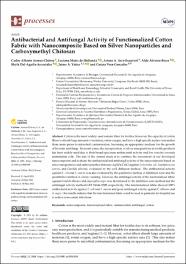Antibacterial and Antifungal Activity of Functionalized Cotton Fabric with Nanocomposite Based on Silver Nanoparticles and Carboxymethyl Chitosan

Ver/
Descargar
(application/pdf: 1.276Mb)
(application/pdf: 1.276Mb)
Fecha
2022-05-30Autor(es)
Arenas-Chávez, Carlos Alberto
De Hollanda, Luciana Maria
Arce-Esquivel, Arturo A.
Aldo Alvarez-Risco
Del-Aguila-Arcentales, Shyla
Yáñez, Jaime A.
Vera-Gonzales, Corina
Metadatos
Mostrar el registro completo del ítemResumen
“Cotton is the most widely used natural fiber for textiles; however, the capacity of cotton
fibers to absorb large amounts of moisture, retain oxygen, and have a high specific surface area makes
them more prone to microbial contamination, becoming an appropriate medium for the growth
of bacteria and fungi. In recent years, the incorporation of silver nanoparticles in textile products
has been widely used due to their broad-spectrum antibacterial activity and low toxicity towards
mammalian cells. The aim of the current study is to continue the assessment of our developed
nanocomposite and evaluate the antibacterial and antifungal activity of the nanocomposite based on
silver nanoparticles and carboxymethyl chitosan (AgNPs-CMC) against Escherichia coli, Staphylococcus
aureus, and Candida albicans, evaluated by the well diffusion method. The antibacterial activity
against E. coli and S. aureus was also evaluated by the qualitative method of inhibition zone and the
quantitative method of colony counting. Likewise, the antifungal activity of the functionalized fabric
against Candida albicans and Aspergillus niger was determined by the inhibition zone method and the
antifungal activity method GBT 24346-2009, respectively. The functionalized fabric showed 100%
antibacterial activity against E. coli and S. aureus and good antifungal activity against C. albicans and
A. niger. Our results indicate that the functionalized fabric could be used in garments for hospital use
to reduce nosocomial infections.
“
Colecciones
- Web of Science (WOS) [236]

